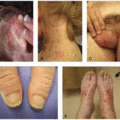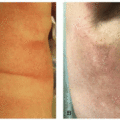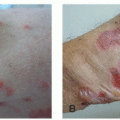Acneiform Reactions
Michelle S. Lee
Vinod E. Nambudiri
Acneiform eruptions are a relatively common skin toxicity, occurring across several drug classes, and are observed in up to 80% of patients treated with epidermal growth factor receptor (EGFR) inhibitors.1 Patients typically present with erythematous papules, and pustules that affect the face, scalp, upper back, and chest (Figure 6.1). The papules may be monomorphic or more inflammatory and diverse in their individual appearance (Figure 6.2). The eruption typically appears 8 to 10 days after EGFR inhibitor initiation, peaking at 2 weeks, though the presentation can sometimes be delayed or triggered by other factors, such as sun exposure.2 The most commonly affected regions of the face include the areas around the nose and mouth, but the cheeks, chin, forehead, and scalp can also be involved (Figure 6.3).2
This reaction pattern is a class effect resulting from EGFR inhibition directly on the hair follicle (on target, off tumor effects) and is observed in use of both EGFR monoclonal antibodies as well as tyrosine kinase inhibitors.2 The presence and severity of these eruptions has been correlated with tumor response and survival for EGFR inhibitors, across malignancy types.2 Studies have also shown that acneiform rash may develop in up to 77% of patients on MEK inhibitors3 where it tends to be very monomorphic and reminiscent of steroid acne. Cases have also been reported for patients on anti-CTLA4 therapy,4 KIT/BCR-Abl inhibitors,5 HER2 inhibitors such as trastuzumab,6 mTOR, and BTK inhibitors.7
Most patients experience a waxing and waning course throughout their treatment duration. With some agents, the severity wanes with prolonged use. Sun exposure and staphylococcal colonization or superinfection can stimulate flares. The eruption typically resolves completely after discontinuation of the offending agent, although some patients may experience postinflammatory hyperpigmentation; this is of particular significance in patients with darker skin types where postinflammatory hyperpigmentation and be prominent and persistent.2 Prophylaxis with bland emollients, sun protection, topical steroids, and oral tetracycline antibiotics can prevent this toxicity in the majority of cases; the topical preventative options can be universally applied in patients
on EGFRi therapy, with consideration for oral antibiotics on a case-by-case basis. Similarly, effective treatment for acneiform eruptions and their symptoms may usually include a combination of topical steroids, emollients, sunscreen, topical antibiotics, oral antihistamines, and oral antibiotic therapy (Table 6.1).5,6,7 However, in refractory cases, prednisone for temporary symptom relief and systemic isotretinoin for long term management can be considered. Importantly, systemic steroids, including those administered as part of a chemotherapy regimen, can induce steroid acne.
on EGFRi therapy, with consideration for oral antibiotics on a case-by-case basis. Similarly, effective treatment for acneiform eruptions and their symptoms may usually include a combination of topical steroids, emollients, sunscreen, topical antibiotics, oral antihistamines, and oral antibiotic therapy (Table 6.1).5,6,7 However, in refractory cases, prednisone for temporary symptom relief and systemic isotretinoin for long term management can be considered. Importantly, systemic steroids, including those administered as part of a chemotherapy regimen, can induce steroid acne.
Stay updated, free articles. Join our Telegram channel

Full access? Get Clinical Tree







